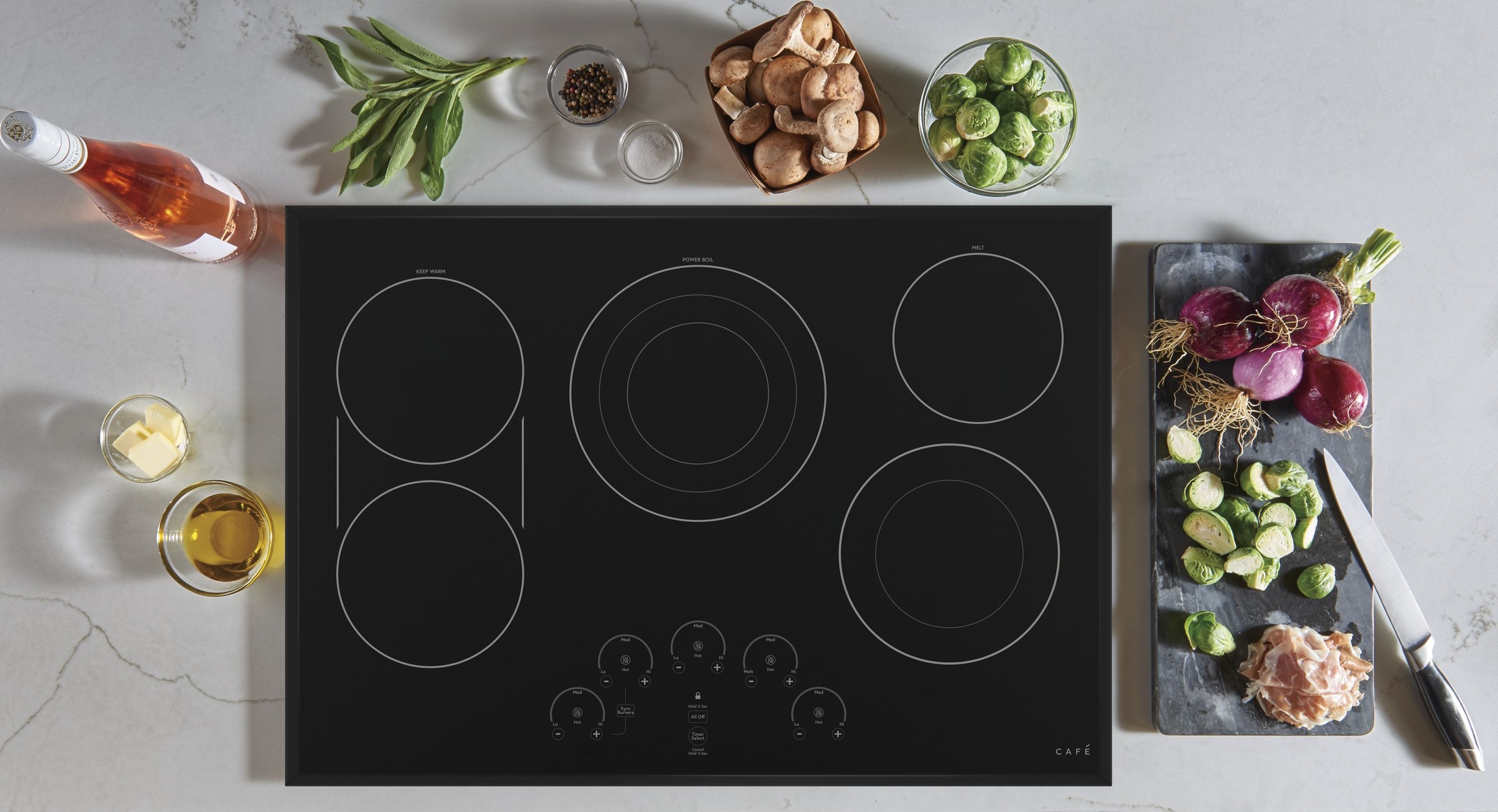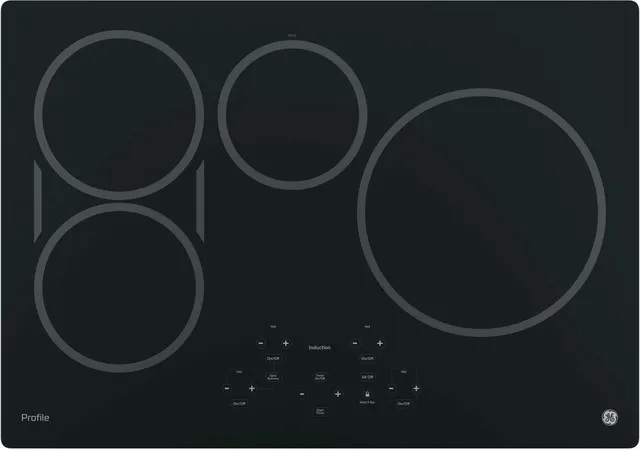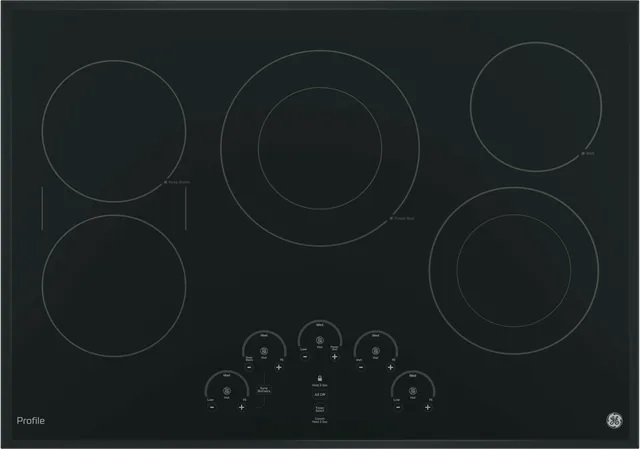- Comparing an Induction vs Electric Cooktop
- Induction Cooktops Pros and Cons
- Electric Cooktops Pros and Cons
- Our Top Picks: Induction Cooktops
- Our Top Picks: Electric Cooktops
- Which is Better: Induction or Electric Cooktops?
If you’ve ever dreamed of flipping pancakes over your kitchen island, then you’ve surely considered a built-in cooktop. Smooth top induction and electric cooktops are especially appealing due to their modern designs that typically feature glide-touch controls, indicator lights, and flexible burners that literally expand the possibilities for mealtime. But despite their similar appearances, there are still compelling differences between an induction vs electric cooktop, and depending on your needs, one may serve your family better than the other.
Different from traditional forms of cooking, induction cooktops use an electromagnetic field to generate heat directly in the cookware, meaning that the cooking surface itself is cooler than a conventional stovetop. By contrast, electric cooktops (also referred to as “radiant cooktops” in this blog) rely on an electrical current that causes a heating element to activate and emanate to the glass or ceramic cooking surface to then transfer heat to the pan.
In this blog, our experts weigh the pros and cons of induction vs electric cooktops to help you decide which smooth top cooktop is best for your family.
Comparison: Induction vs Electric Cooktop: GE Profile
Before we assess the performance quality of an induction cooktop vs electric cooktop, check out this easy-to-reference table that compares two of our top-rated cooktops from each category—stay tuned for more in-depth reviews of both GE Profile appliances.
| Product Attributes |
|
| |
|---|---|---|---|
| MSRP |
$1,554
|
$1,443–$1,554
| |
| Maximum Number of Pans |
5
|
5
| |
| Cooktop Burner Type | Smooth top |
Smooth top
| |
| Control Type | Glide Touch |
Glide Touch
| |
| Control Location | Front Center |
Front Center
| |
| Indicator Lights | 5 Hot Surface; Red; Setting Level Indicators; Surface Element “ON” |
5 Hot Surface; Red; Setting Level Indicators; Surface Element “ON”
| |
| Melt Setting? | Yes |
Yes
| |
| Timer? | Yes |
Yes
| |
| Bridge Element? | Yes |
Yes
| |
| Keep Warm Setting? | Yes |
Yes
| |
As you can glean from this data, induction and radiant cooktops are stocked with identical features within the same brand. As far as pricing goes, they may cost around the same, but depending on the manufacturer, induction cooktops may have a heftier price tag than electric models.
Induction Cooktops Overview

Pictured: Electrolux 36” Black Induction Cooktop (ECCI3668AS)
Let’s start with induction cooktops. Compared to electric cooktops, induction cooktops are a little less variant across models, as they are largely defined by a glass top surface. By contrast, some entry-level electric cooktops may have metal coils on top of the cooking surface—as opposed to below it.
Despite their similar appearances, the most significant visual cue that distinguishes an induction cooktop from a smooth top electric cooktop is that there isn’t a natural, heat-generated glow to indicate that the appliance is on. Since the electromagnetic field does not generate a heated glow, many manufacturers add virtual flames or other lighting cues to indicate which surface elements are on.
Visuals aside, induction cooktop efficiency vs electric cooktop efficiency is a central debate when choosing one product over the other. Up to 90 percent of the energy produced on an induction cooktop is transferred to the food—which is astounding considering that the energy transfer for electric and gas cooktops is estimated to be 74 and 40 percent, respectively.
Plus, induction cooktops require induction-compatible cookware, as either iron or a magnetic layer is needed for the magnetic coils underneath the cooking surface to power the cooktop. Compatible cookware materials include cast iron and most types of stainless steel while largely excluding glass, all-copper, and aluminum pots and pans—unless the bottoms have a magnetic layer.
Here are the pros and cons associated with owning an induction cooktop, summed up:
Induction Cooktops Pros
✓ Energy efficiency is at the forefront with 90 percent of power being transferred to the food.
✓ Food is heated more quickly.
✓ The cooking surface stays cooler for safer use—and quicker cleanup.
✓ The cooktop is more responsive to changes in temperature control.
Induction Cooktops Cons
☒ Induction-compatible cookware is required.
☒ Loud buzzing is common at higher settings.
☒ Cooktops are, on average, more expensive starting at around $1,000.
Electric Cooktops Overview

Pictured: Cafe 30” Black Built In Electric Cooktop (CEP90301NBB)
Onto electric cooktops! Radiant cooktops are particularly popular, offering centralized heat for your pots and pans. Underneath the surface of the glass or ceramic top, there is an electrical current that flows through a metal coil, which glows hot and then transfers heat through the smooth top surface using infrared energy. This infrared energy enables even heat distribution from the burner to the pan, which then transfers to the food.
A major difference between an induction cooktop vs electric cooktop is that once you turn off a burner from an electric cooktop, the surface will continue to be hot, even after the electrical current stops. The burner will give off residual heat for an undetermined amount of time. This, of course, is unlike induction cooktops, which cool down instantly.
Here are the pros and cons associated with owning an electric cooktop, summed up:
Electric Cooktops Pros
✓ Cooktops are easy to install and use with intuitive controls.
✓ Energy efficiency is about 34 percent better than that of a gas cooktop.
✓ Radiant cooktops are less expensive upfront compared to gas and induction models—starting at around $600.
Electric Cooktops Cons
☒ Residual heat may leave you with a surface that is hot to the touch after cooking, which may pose a hazard.
☒ Cooktops may take longer to heat up.
☒ Heat may not be distributed evenly through the coils.
Our Top Picks: Induction Cooktops
After spelling out the benefits of an induction vs electric cooktop, we are offering a look into the top-rated products our experts cannot stop raving about.
First up: Here are the best induction cooktops our catalog has to offer.
Best Overall: GE Profile Series 30” Black Built-in Touch Control Induction Cooktop

With this GE Profile induction cooktop (PHP9030DJBB), you can enjoy a new level of rapid, precise heating with a cool-to-the-touch surface that is easy to clean. You can control two 7-inch elements simultaneously to evenly heat large cookware or griddles for multiple grilled cheeses, quesadillas, tacos, pancakes, and burgers on demand. Best of all, you can cook efficiently with elements that heat to the size of your pan and shut off when no pan is present.
Related: What is Smart Cooking?
Best Value: Thor Kitchen 30” Black Induction Cooktop
This Thor induction cooktop (HIC3001) offers the power and performance of a professional appliance at a practical price. Featuring four induction elements, touch controls, a residual heat indicator, and a sleek design, this cooktop is equipped to handle everything from simple dishes to haute cuisine. Most conveniently, the HIC3001 is stocked with an independent countdown timer an automatic safety off-switch.
Best Luxury: Bosch Benchmark 36” Black Induction Cooktop
Making space for more, this Bosch Benchmark induction cooktop (NITP669UC) helps you juggle multiple dishes by speeding up the cooking process with the SpeedBoost™ function and FlexInduction®, a bridge element that can combine two cooking zones into one for larger cookware. This luxury-tier induction cooktop even allows you to accommodate pots and pans up to 9 inches wide and 15 inches long, making preparation for dinner parties a breeze.
Our Top Picks: Electric Cooktops
Next up: Here are our picks for the best electric cooktops.
Best Overall: GE Profile Series 30” Black Electric Cooktop

This sleek GE Profile electric cooktop (PP9030DJBB) helps you cook foods quickly and evenly, with the ability to manage up to five pans at once with individual timers for each radiant element. Thanks to glide-touch controls, precise temperature control is instant and easy with one swipe.
Best Value: Frigidaire 30” Black Electric Cooktop
If you’re looking for a high-performing cooktop that won’t break the bank, this Frigidaire electric cooktop (FFEC3025UB) does not disappoint. With two different element sizes and helpful indicator lights that alert you when the cooktop is on or too hot to touch, this frameless drop-in cooktop makes it easy to cook dinner while managing a household. Plus, intuitive controls make it easy to select cooking temperatures and options for different types of cuisine.
Best Luxury: Miele 36” Black Electric Cooktop
If your budget can afford your ambitions for more, this sprawling Miele electric cooktop (KM5860240V) stands to be your saving grace in the kitchen. Among its luxurious amenities, this electric cooktop offers auto heat-up on every cooking zone and numerical linear keybanks that allow you to easily select power levels and cook times. Its attractive design and stainless-steel frame are bound to elevate your kitchen design while residual heat indicators are built into all five elements, keeping you and your loved ones safe.
Which is Better: Induction or Electric Cooktops?
So, in the induction vs electric cooktop debate, which one is best for you? If you prioritize energy efficiency and consider yourself an advanced home cook, then you may find there is much to appreciate from an induction cooktop—from the ultra-precise temperature control and quicker performance. In terms of convenience, induction cooktops are hailed for their rapid cooldown, enabling both faster cleanup and safer operation.
On the other hand, if you prefer to stock your cooking station with the bare necessities and have a tighter budget, then an electric cooktop might be the most compatible purchase. Like induction models, radiant cooktops also exude a luxe appearance with a smooth top surface and glide-touch controls, meaning you can still reap the benefits of a built-in kitchen aesthetic.
Shop Induction and Electric Cooktops at Spencer’s
As always, don’t forget to shop local! Be sure to scour our catalog of top-rated cooktops, and if you have other questions about any of our name-brand appliances, don’t hesitate to call or visit your friends in the business at Spencer’s TV & Appliance. Proud to have served our customers since 1973, we have 10 locations in the Phoenix, Scottsdale, and Glendale regions. Call or visit us today!



